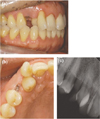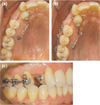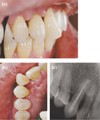Abstract
The clinical diagnosis of ankylosis can be made only when the affected tooth gives positive evidence of an inability to move. The inability to move is demonstrated either as a failure of the tooth to move with normal vertical dental alveolar growth or a failure of the tooth to move when the tooth is subjected to an orthodontic force system. This case report describes the autotransplantation of an ankylosed maxillary canine.
Figures and Tables
References
1. Nahm DS, Baik HS, Cha KS. Textbook of orthodontics. 2006. 2nd ed. Seoul: DaehanNarae Publishing Inc.;279–280.
2. Isaacson RJ, Strauss RA, Bridges-Poquis A, Peluso AR, Lindauer SJ. Moving an ankylosed central incisor using orthodontics, surgery and distraction osteogenesis. Angle Orthod. 2001. 71:411–418.
3. Andreasen JO. Relationship between cell damage in the periodontal ligament after replantation and subsequent development of root resorption. Acta Odontol Scand. 1981. 39:15–25.

4. Andreasen JO, Kristerson L. The effect of limited drying or removal of the periodontal ligament. Periodontal healing after replantation of mature permanent incisors in monkeys. Acta Odontol Scand. 1981. 39:1–13.




 PDF
PDF ePub
ePub Citation
Citation Print
Print






 XML Download
XML Download